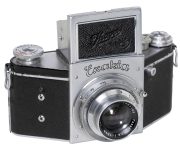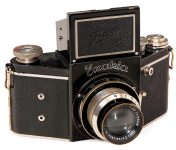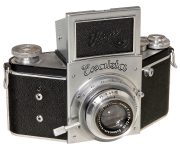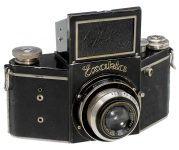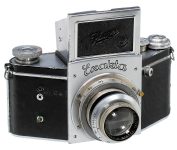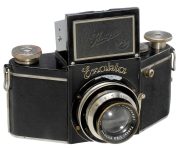Announced
Production status
System
VP Exakta system cameras
Exakta B
Medium format MF film SLR camera • Discontinued
Specification
| Format: | |
| Medium format 6.5x4 | |
Film type: | 127 roll film |
| VP Exakta | |
| Shutter: | |
Type: | Focal-plane |
Model: | Mechanical |
Speeds: | 12 - 1/1000 + B, Z |
| Exposure: | |
Exposure metering: | None |
Exposure modes: | Manual |
| Physical characteristics: | |
Weight: | 750g |
Dimensions: | 150x65x50mm |
Manufacturer description #1
This represents the most popular equipment of the Exakta. Instantaneous exposures of highest speeds from 1/25th to 1/1,000th sec. Short and long time exposures from 1/10th, 1/2 to 12 sec. Delayed action release for exposures from 1/1000th to 6 sec.
The Delayed Action Control allows 12 seconds to elapse after the release has been pressed before the shutter operates.
Body made entirely of metal, leather covered, with spring safety cover to the film-recording aperture for use with Panchromatic films, and fitted with Tripod Bush and Cable Release.
Manufacturer description #2
Sloped body, cast in light alloy, with fine leather covering. Focussing on ground-glass screen either at waist or eye-level. Spring-up finder hood with supplementary focussing magnifier. Frame view-finder. Lens in helical screw mount, focussing from infinity to 3 feet. Infinity stop, and lock for shutter release when lens is withdrawn into camera. Tripod bush in camera base. Leather neck sling, connections for flash-bulb synchroniser, and chrome-plated front and cover plate.
Manufacturer description #3
Standard Model V.P. EXAKTA
8 exposures 2 1/2 in. x 1 5/8 in.
(4 x 6.5 cm.) on A.27 Film
This is the standard model which takes the popular V.P. size film. The larger negative size appeals to quite a number of photographers, for it does not necessarily require enlarging to be effective as a picture. The image seen in the ground glass is the full size of 2 1/2 in. x 1 5/8 in., and an additional magnifier is provided for critical focussing.
The main equipment of this models is:-
1. Self-capping focal plane shutter with speeds from 12 seconds to 1/1000th and delayed action on all speeds from 6 second to 1/1000th.
2. Focussing or Iconometer Direct Vision Viewfinder.
3. Precision Interchangeable Lens Flange.
4. Built-in Focussing Magnifier.
A special plate back model is available for all 2 1/2 in. x 1 5/8 in. cameras with lenses up to F/2.8 aperture, and is of great value where single exposures must be made.
General Specifications. - Measurements of body, including lens mount, 6 in. x 3 in. x 2 3/4 in.; weight, 26 ozs. Light metal body covered with best leather. Ground glass focussing screen with self-erecting hood, focussing from 3 feet to the infinity stop.
Manufacturer description #4
Size of Picture
"Exakta" pictures 2 1/2 X 1 5/8 in. (4 X 6 1/2 cm) are quite effective even as prints. It will be easy however, to produce enlargements up to 12 x 10 in. and even larger ones, without reducing the pictorial effect and without resorting to special tricks.
Compared with square sizes, the rectangular "Exakta" size affords the great advantage complying with aesthetic requirements. Possibly 90% of all exposures require by their nature the vertical or horizontal sizes which prevail in the paintings by famous masters.
Image in View Finder
Whether the picture is focussed sharply or stopped down to obtain greater depth of definition, or whether the view has been chosen correctly, so that subsequent trimming is eliminated and non-essentials have been omitted: the clear image reflected by the mirror being the exact size of the finished picture shows everything prior to exposure. Nothing can be more satisfactory than working with a mirror reflex camera. No tiny image in the finder! No estimating of distances, no time consuming checking of distance meters and tables! The ingeniously designed light-hood may be converted into a frame finder with sight, highly nontier with press and sports photographers, and the reflex device can be used also for exposures at eye level.
Another Important Point
Only a mirror reflected image as produced by the "Exakta" lens is always reliable and absolutely identical with the final picture. Has it not happened to you, in spite of accurate observation through the finder, that, particularly in close-up pictures, the body of a person was taken without the head? No matter whether the view finder was built into the camera or attached thereto? Such failures are due to a separate finder and taking lens: the parallax.
Focussing
The large reflected image reduces the work of adjusting the diaphragm and the focussing to almost automatic operations. By means of a precision helical mount, focussing to correct sharpness takes place with microscopic accuracy. Further a magnifier built into the hood may be relied on in case of ultra critical focussing.
Double Exposures
are impossible with "Exakta", as the act of changing the film winds up the shutter and brings the reflex mirror into operating position.
Shutter
A high-grade camera requires a first-class shutter. The self-capping focal plane shutter, on which the speeds can be easily read, gives instantaneous exposures from 1/25th to 1/1000th sec. as well as short and long time exposures of 1/10th, 1/2, 1 to 12 sec. without automatic release and exposures from 1/1000th to 6 sec. when the delayed action release is used. The "Exakta" focal plane shutter is reliable and precise and more efficient than the usual shutters. Whether you wish to take a picture of every-day life, or a moving car or aeroplane or of a sporting or similar high-speed event, your "Exakta" will not fail you!
Range of Usefulness
The "Exakta" is remarkably efficient in every way, a real universal camera. There is not a sphere in which its numerous advantages cannot be utilised, including landscape or portrait work, scientific, sport, night or stage photography. The small number of exposures on a spool allows for quick developing without loss of time or money. Scientists and research workers may use also telephoto or wide-angle or additional lenses, and even then the mirror-reflected image will be absolutely reliable. The lens can be changed while the camera is loaded. A press photographer equipped with an "Exakta" can surmount all obstacles; in a crowd he can photograph over people's heads and watch the subject from below. For pictures of every-day life or for detective work "Exakta" is especially suited, as vertical pictures can be taken at an angle of 90° to the subject unobserved, which would be impossible by direct work.
Shape and Weight
The beautiful form of the "Exakta" is particularly attractive. Its handy body lies conveniently in your hand during the taking of a picture. The elegant trapezoid form is not only beautiful but insures the utmost utilisation of space. Provided with reflex mirror, focal plane shutter, and the most rapid lens, the "Exakta" nevertheless appears to be hardly larger than an ordinary roll film camera.
Manufacturer description #5
The Standard Exakta, taking pictures 4x6.5 cm. (2 1/2 x 1 5/8") has become exceedingly popular all over the world during the last few years. Nor is this surprising, for apart from the good technical points relating to the camera, the contact print of a Standard Exakta negative is large enough for direct viewing, and there is no essential need for enlarging. Where enlargements are wanted for framing, or for exhibitions, the standard negative size has points of advantage, and there is no great difficulty involved in enlarging it to 30 x 40 inches. Even beyond this level, there is no deterioration of image quality, and no special methods are required. The long-shaped image 2 1/2 x 1 5/8 inches has been specially arranged to suit most subjects taken with an ordinary camera.
Focussing and setting the lens aperture is utter simplicity, on account of the full-sized image shown on the focussing screen. The lens is mounted on a precision-made helical screw mount, and sharp focussing down to three feet distances is made possible by an accurate scale. At still closer, the extension tubes or supplementary lens may conveniently be used. A supplementary magnifier built into the finder hood can be used for critical focussing, and through it a considerably enlarged image of the centre of the focussing screen is seen. By bending backwards the upper metal mirror of the finder hood, the image on the focussing screen can be seen when the camera is at eye-level. Double exposures are impossible with the Exakta camera, since winding on the film to the next number simultaneously resets the shutter. The shutter release is locked if the lens is set back for carrying, and is only put in action again when the lens mount has been rotated forward to focus on infinity.
The shape of the Exakta is particularly pleasing, and the unusual bevelled edges permit it to be held in comfort and convenience during exposure. This camera shape not only helps the user, but is actually the most effective way of using up space. Serious amateurs will further welcome the fact that the Standard Exakta can be obtained with a plate back: in this case reflex focussing cannot be used, so the image is observed on a ground-glass screen before inserting the plateholder. An accurate focussing scale for plates is also provided.
The roll-film used in the Standard Exakta gives eight exposures in the 2 1/2 x 1 5/8" size, so that a large number of exposures need not be taken before the film is developed.
From the Classic Camera magazine (November 2002)
In 1937, following Zeiss Ikon's unveiling of the Contax II and Contax III in chrome finish, the fad for chrome as the ultimate in elegance swept Germany.
Ihagee also switched over to this finish, presenting in 1938 the Exakta B and Night Exakta with top plate, front lens panel and metallic parts of the finder hood in satin-finish chrome.
This chrome finish is a further element of diversification among Exakta models for collectors and is a sign of distinction.
From the editor
While the first models of the Exakta B were fitted with a film transport knob, and had black enamelled finish of the metal parts, later models were equipped with a film transport lever instead of the knob, and finally the latest batches of this model had chromium finish of the outside metal parts.

